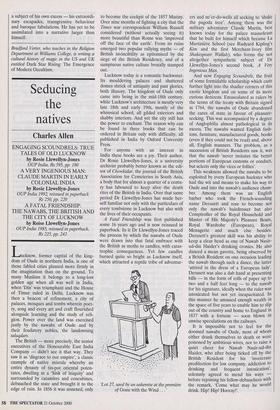Seducing the natives
Charles Allen
Lcknow, former capital of the king- dom of Oude in northern India, is one of those fabled cities planted more firmly in the imagination than on the ground. To many Muslims it belongs to a long-lost golden age when all was well in India, when 'Din' was triumphant and the House of Timur ruled in Delhi. Lucknow was then a beacon of refinement, a city of palaces, mosques and tombs wherein poet- ry, song and every art and craft flourished alongside learning and the study of reli- gion. Power over the land was exercised justly by the nawabs of Oude and by their feudatory nobles, the landowning taluqdars.
The British — more precisely, the senior executives of the Honourable East India Company — didn't see it that way. They saw it as 'disgrace to our empire', a classic example of native misrule whereby an entire dynasty of tin-pot oriental poten- tates, dwelling in a 'Sink of Iniquity' and surrounded by catamites and concubines, debauched the state and brought it to the edge of ruin. In 1856 it was annexed, only to become the cockpit of the 1857 Mutiny. Over nine months of fighting a city that the Times war correspondent William Russell considered (without actually seeing it) more beautiful than Rome was 'improved off the face of the earth'. From its ruins emerged two popular rallying myths — of British invincibility as epitomised by the siege of the British Residency, and of a sumptuous native culture brutally stamped out.
Lucknow today is a romantic backwater. Its mouldering palaces and shattered domes shriek of antiquity and past glories, both illusory. The kingdom of Oude only came into being in the mid-18th century, while Lucknow's architecture is mostly very late 18th and early 19th, mostly of the whimsical school, all gilded exteriors and shabby interiors. And yet the city still has the power to enchant. The reason why can be found in three books that can be ordered in Britain only with difficulty, all published in India by Oxford University Press.
For anyone with an interest in India these books are a joy. Their author, Dr Rosie Llewellyn-Jones, is a university archivist probably better known as the edi- tor of Chowkidar, the journal of the British Association for Cemeteries in South Asia, a body that for almost a quarter of a centu- ry has laboured to keep alive the death rites of the British in India. Over that same period Dr Llewellyn-Jones has made her- self familiar not only with the particulars of every tombstone in Lucknow but also with the lives of their occupants.
A Fatal Friendship was first published some 16 years ago and is now reissued in paperback. In it Dr Llewellyn-Jones traced the process by which the nawabs of Oude were drawn into that fatal embrace with the British as moths to candles, with catas- trophic consequences. Yet few candles burned quite so bright as Lucknow itself, which attracted a reptile tribe of adventur- 'Lot 27, used by an usherette at the premiere of Gone with the Wind . . ers and ne'er-do-wells all seeking to 'shake the pagoda tree'. Among them was the military adventurer Claude Martin, best known today for the palace mausoleum that he built for himself which became La Martiniere School (see Rudyard Kipling's Kim and the first Merchant-Ivory film Shakespeare Wallah), who forms the not altogether sympathetic subject of Dr Llewellyn-Jones's second book, A Very Ingenious Man.
And now Engaging Scoundrels, the fruit of some formidable scholarship which casts further light into the shadier corners of this exotic kingdom and on some of its more curious denizens. Emasculated as rulers by the terms of the treaty with Britain signed in 1764, the nawabs of Oude abandoned the cares of state in favour of pleasure- seeking. This was accompanied by a degree of Anglophilia almost pathological in its excess. The nawabs wanted English fash- ions, furniture, manufactured goods, books (even if they could not be read) and, above all, English manners. The problem, as a succession of British Residents saw it, was that the nawab 'never imitates the better portions of European customs or conduct, but selects only the vices or follies'.
This weakness allowed the nawabs to be exploited by every European huckster who had the wit and means to make his way to Oude and into the nawab's audience cham- ber. Among them was an English barber who took the French-sounding name Derusett and rose to become not only the nawab's hairdresser but also Comptroller of the Royal Household and Master of His Majesty's Pleasure Boats, Royal Wardrobe (European), Royal Menagerie and much else besides. Derusett's greatest skill was his ability to keep a clear head as one of Nawab Nasir- ud-din Haider's drinking cronies. He also danced a mean gavotte, being observed by a British Resident on one occasion leading the nawab through such a dance, the latter `attired in the dress of a European lady'. Derusett was also a dab hand at presenting bills — in the form of rolls of paper up to two and a half feet long — to the nawab for his signature, ideally when the ruler was intoxicated but not yet incapacitated. In this manner he amassed enough wealth in the space of five years to enable him to slip out of the country and home to England in 1837 with a fortune — soon blown in unwise speculations on the railways. It is impossible not to feel for the doomed nawabs of Oude, most of whom either drank themselves to death or were poisoned by ambitious wives, nor to raise a quiet cheer for Nawab Nasir-ud-din Haider, who after being ticked off by the British Resident for his 'inveterate predilection for low company, addiction to drinking and frequent intoxication', solemnly agreed to mend his ways before rejoining his fellow.:debauchees with the remark, 'Come what may he would drink. Hip! Hip! Hooray!'.

























































































 Previous page
Previous page